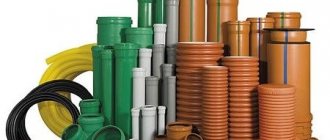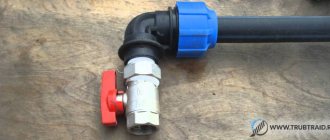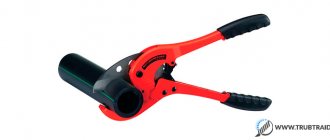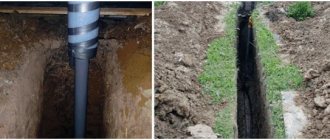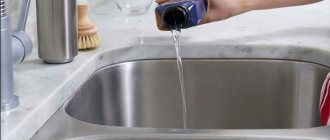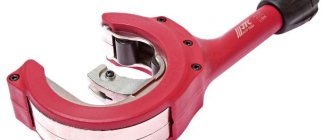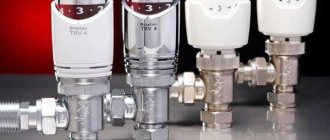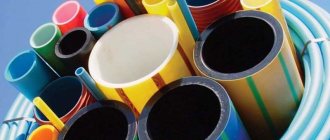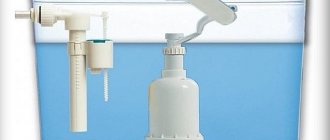Selection of plastic pipe plugs: types, methods of application
Plugs for plastic (plastic) pipes are fittings of a fairly simple design that are used to limit the flow of water in a pipeline.
In addition, these shaped elements can be used in other cases when it is necessary to make the pipe airtight: for example, when installing fences. In order to install a plug on a pipe, no special skills are needed. The range of such fittings is wide: both the shapes of the plugs and their diameters vary. Plugs are a special type of fittings installed on pipelines and other pipe structures
Where are plastic pipe plugs used?
Such shaped parts as plugs are indispensable when a pipeline or a separate part of it needs to be insulated. At the same time, it is not advisable to weld the end of a metal pipe - it is possible that devices will be connected to the structure in the future or other pipeline segments will be built onto it.
Plastic plugs are useful in the following cases:
- When installation of a sewer inspection is required. Due to the configuration of the sewer system, it is sometimes more desirable to install a plug on a horizontal section of the pipe to prevent blockages than to use special sections of the sewer with inspection.
Important ! True, such a solution is not relevant for apartments in multi-storey buildings, since when this part is removed, the environment in the system will begin to pour out. A more acceptable option would be to use an oblique tee with the socket pointing upward.
- Restriction of water supply in a certain branch of the sewer system. When a water supply or sewer system is being repaired or installed, and some elements (devices) are not ready for installation, the easiest way is to temporarily plug the pipeline. The same method works in case of emergency situations in the house.
- Plugs can be used as a decorative element. Square plastic plugs have found this application in the furniture industry. When installing fences made of corrugated pipe and sheet metal, the posts also need to be sealed so that debris and moisture do not get into their cavity.
- When working with polypropylene pipes. Plastic plugs for polymer pipes are welded onto a section of pipeline using a soldering iron. If it is necessary to resume the water supply, the fitting is simply cut off. Any other fitting can be welded in place of the plug.
In new sewerage systems, plugs are placed in places where consumers are planned to be connected in the future
In addition, plugs are also produced for pipes in polyurethane foam insulation. Metal fittings with output cable are not supplied as separate products, they can only be purchased complete with pipes. With thermally insulated pipes, it is also possible to use a polymer plug for PPU pipes. This fitting protects bare steel areas from moisture ingress and can also ensure the integrity of the remote control cable.
How to choose the right plastic plug?
You can select a fitting for sealing without even consulting a professional. In addition to visual characteristics (smooth surface, absence of manufacturing defects, uniformity of material), attention should be paid to the technical properties of the plugs:
- Section. To isolate water supply and sewerage systems, plastic pipe plugs with a round cross-section are used. They must exactly match the diameter of the pipeline. For profile structures you will need not round, but rectangular or square plugs. These shaped elements, in turn, must match the length and width of the pipe section.
- Material. Plastic pipe plugs, both square and round, are made from the same material as the products that need to be insulated. For pipes made of polyvinyl chloride, shaped elements are made of PVC, respectively, and pipelines made of HDPE can only be insulated with fittings made of low-density polyethylene.
- Purpose. Fittings differ in their degree of reliability. If a temporary restriction of the system is required, then shaped elements designed for manual sealing are quite suitable. For long-term fixation, fittings for welding or with a threaded connection are needed.
For decorative purposes, you can choose a cap of any color and shape.
For decorative purposes, polyethylene plugs are most often produced. This material has a low price, it is plastic and soft. Such shaped elements can have different colors: the color is added to polyethylene when the polymer is in a molten state. This property allows you to maintain a uniform color of the surface of the fitting even when defects appear on it due to active use.
Installation of plugs in pressure and non-pressure pipelines
The method of installing fittings will differ depending on whether the pipeline is pressure or non-pressure. If the system is non-pressure, then the pressure of the medium in it will be minimal, and usually does not exceed one atmosphere. In this case, installation of plugs in the socket is possible. Installation of plugs in non-pressure systems is carried out in several steps:
- It is necessary to select a fitting installed in the socket with optimal characteristics: diameter, cross-section, material of manufacture. Along with a plastic plug for round pipes, a rubber O-ring is purchased - it will give the joint greater strength.
- Before installation, a rubber ring is installed on the pipe section.
- The walls of the fitting are lubricated with a soap solution. The product is inserted into the pipe manually: this requires physical effort.
Fitting selection criteria
The plug is selected according to several parameters:
- Material of manufacture. As a rule, PVC fittings are used for metal-plastic pipes, polyethylene for PET, and steel or brass for metal. Rubber ones are used as temporary ones.
- Diameter, size and shape. The cross-section of the plugs must exactly match the parameters of the communication pipes. In addition, round fittings are used for round elements, and square fittings are used for profile elements.
- Purpose. For long-term sealing of the pipe, it is better to buy a threaded or elliptical fitting. If the plug is installed for a short time, it is better to use a flange one. Moreover, it is not recommended to buy rubber and polymer plugs for the hot water system or heating pipes. They change their shape when exposed to high temperatures. As a result, system depressurization may occur. Pneumatic and threaded plugs are not installed on gas pipelines. It is better to use flanged ones here.
Decorative plugs are made from PET in various shades. The color is added to the polymer at the casting stage. The fitting is painted uniformly throughout the entire thickness of the plastic.
How to plug a pipe with pressurized water?
Putting a plug on a pipe is not a tricky thing if you do it without pressure.
But when the water cannot be turned off, many will think that it is impossible to do so. However, it is not.
It will not be possible to install a regular plug, since the strong pressure will not even make it possible to attach it to the thread.
But if you use a regular water tap instead, everything will work out.
The method is to switch the tap that will plug the pipe into open mode - water will pass through it and thereby make it possible to attach it to the threads of the pipe. As soon as the plug valve is attached and tightened a few turns, it can be closed.
Before work, you need to make sure that nothing will interfere with the work, and also prepare a container for collecting water and a rag for cleaning (so as not to drown your neighbors).
This method can be used even if the pipe to be plugged is without a thread - then you need to put a flexible hose on the plug valve that fits onto the pipe.
The tap, as in the first case, must be fully opened, and the hose must be placed on the pipe - it must be secured with one or two clamps. After this, you can finally turn off the water.
Important. This method cannot be used to plug hot water pipelines without completely shutting off the system.
Turning off gas for non-payment: description of the procedure, procedure and rules
The subscriber must ensure unhindered access for specialists to equipment and pipelines
It is especially important not to create obstacles for service company workers if they need to localize or eliminate the consequences of accidents. In emergency situations, access to specialists must be provided at any time upon presentation of their identification
Illegal actions of the consumer may create a safety hazard for other residents and their property. What happens to the body of a person who does not have sex? Sex is almost as basic a need as eating. At least once you start doing it, you won’t stop.
Even if you adhere to... Sexuality What to do after intimacy: 9 rules You've finished having sex. Maybe it was good, maybe it was bad, but that's not the point. The process is over.
Sealing plastic pipes
We will immediately see that there are two types of sealing of plastic pipes: permanent and temporary. The choice of one or another blocking method is determined not only by the pipe material, but also by the condition of the entire pipeline as a whole.
Thus, temporary sealing is used when access to the pipe is difficult and involves the use of a special polypropylene plug with internal thread. Before installing it, an external thread is cut on the plastic pipe using a die of the appropriate size.
Advice! To permanently block the plastic channel, it is best to use a special welding device (soldering iron). The adhesion of elements in such a compound is carried out at the molecular level, which provides it with the necessary strength. We also note that using a soldering device you can also fix a simple plastic plug on the pipe.
Plug for a water pipe - review and installation on vodatyt.ru
A plug for a water pipe is an element of shut-off valves used as permanent or temporary measures to eliminate water leaks. During the installation of a water supply system, situations arise when you need to plug a pipe, and this is where a plug comes to the rescue.
How to plug a water pipe
The procedure itself is simple, and if you have basic knowledge and skills in the repair and construction field.
Those who have not encountered plumbing work should adhere to the following recommendations:
- Threaded connections are sealed using FUM tape. This is necessary for sealing.
- Before plugging the water pipe, you need to turn off the ball valve and cut it off from the supply system.
- The welding machine must be used in accordance with safety requirements.
- If a flange plug is installed, the bolts must be the same size as the holes made.
A decorative plug works on the same principle as a regular one, and therefore, during installation, all requirements must be met. The technology for installing fittings differs depending on the pipeline materials.
Metal is different in that such a pipe can be threaded, welded (except for cast iron), flanges can be installed, which means any methods can be used. You need to choose one that has all the necessary tools at hand. Plugs are made from different materials, and the choice depends on what kind of subpipe it is.
Cast iron pipe can be terminated with flanged fittings. The welding machine is useless; cutting threads will not work. In this case, sealing is performed with cotton fiber. Steel is a more malleable metal, and all those methods that are not available in the case of cast iron can now be applied.
Installation of plugs
Now let's look at how to put a plug on a pipe. In most cases, this operation does not cause difficulties even for people who do not have special knowledge.
The external plug for pipes is installed based on its design features. When installing fittings, the following rules must be followed:
- It is advisable to use sealing material to seal threaded connections. For example, fum tape is optimal for water supply pipes;
Material for sealing and insulating pipe joints
- When installing a pneumatic plug, compliance with safety rules and control of the amount of incoming air is required. Otherwise, the device may “burst”;
- if an elliptical plug is installed, the fitting installer must know the simplest welding methods and strictly follow safety precautions when working with the welding machine;
- For flange plugs, the fixing bolts must exactly match the dimensions of the prepared holes. Otherwise, the plug will not perform its function.
You can watch the video about the selection and installation of plugs using the example of fence pipes.
Characteristics of metal-plastic pipes, range and installation
Almost everyone has had to deal with the problem of choosing pipes. As a rule, such a need arises when it is necessary to repair or completely replace sewer pipes, heating or water supply systems. If previously only metal products were used, today mainly polymer or metal-plastic pipes are used. Let's look at what metal-plastic pipes are, their technical characteristics and purpose.
When planning to repair a pipeline, many choose metal-plastic pipes. The characteristics of the metal-plastic pipe allow the material to be used in heating and water supply systems.
Metal-plastic pipes have a long service life and are reliable enough that the pipeline assembled from them can last several decades without problems.
- What is a metal-plastic pipe?
- What types of metal-plastic pipes are produced?
- Specifications
- Pros and cons of metal-plastic pipes
- Advantages of the material
- Disadvantages of the material
- How to choose pipes?
- Installation of metal-plastic pipes
What is a metal-plastic pipe?
Modern metal-plastic pipes are structures consisting of several layers. An aluminum pipe is located in it. The thickness of the pipe wall varies between 0.2 - 2 mm.
Inside and outside, the pipe has a plastic shell made of PE-X (polyethylene) polymer material. Since the layers of metal and plastic are connected to each other with glue, the pipe can be called a five-layer structure.
What types of metal-plastic pipes are produced?
There are several types of metal-plastic pipes, they differ:
- By size. The dimensions of metal-plastic pipes allow these products to be used for assembling pipelines for various purposes.
- By manufacturer. On sale you can find domestically produced pipes, as well as imported products.
- The versatility of pipes and fittings. There are pipes on sale that must be purchased complete with fittings from the same manufacturer, but there are also universal products that are suitable for a standard coupling, plug and any other fitting.
Specifications
Manufactured metal-plastic pipes - GOST R52134-2003 must meet the following requirements:
- The diameter of metal-plastic pipes ranges from 16 mm to 63 mm; these sizes are ideal for assembling heating and plumbing systems.
Advice! Before assembling the pipeline begins, it is worth clarifying what the thickness of the pipe wall is. For example, a 16 mm pipe may have a wall thickness of 2 mm. In this case, the internal diameter of a 16 mm pipe will be equal to 12 mm.
- What pressure will the pipe withstand? During operation, the operating pressure can rise to 10 atmospheres inclusive.
- What temperature can a metal-plastic pipe withstand? Most products have an operating temperature of up to +95 degrees. For a short time, the pipes can operate in normal operation; if the temperature is elevated, the product can withstand exposure to +110 degrees.
Pros and cons of metal-plastic pipes
When choosing a metal-plastic pipe, it is worth getting acquainted with their properties. What are the pros and cons of metal-plastic pipes?
Advantages of the material
- Light weight compared to metal ones.
- One hundred percent corrosion resistance and no scale.
- There is no need to paint the pipes.
- Low noise level when transporting liquid.
- Long service life of metal-plastic pipes. If you correctly install and connect metal-plastic pipes with your own hands and do not violate the operating rules, then repair of metal-plastic pipes will be required no earlier than 20 years after installation.
Advice! Metal-plastic pipes allow bending with a radius of up to 3.5 diameters; a support spring is used to perform the bending. If a spring is not used, bending up to 5 diameters is possible.
Disadvantages of the material
There are also disadvantages of metal-plastic pipes. Among them:
- The material is flammable, so it is better to install the pipeline in the grooves of walls or floors, where metal-plastic is not in danger.
- Due to the difference in the thermal expansion of aluminum and plastic, with a sharp change in the temperature of the transported medium, the pipe may delaminate into adhesive layers.
- Instability to ultraviolet radiation. Metal-plastic pipes must be protected from direct exposure to sunlight. Otherwise, you will soon have to look for the answer to the question of how to repair a metal-plastic pipe. Meanwhile, repairs in this case are impossible; the wiring of metal-plastic pipes will have to be completely changed.
Features of gasification of residential buildings
With the help of gas, you can successfully organize heating, hot water heating, and cooking in your home. Gas equipment is reliable and diverse, and the cost of blue fuel is usually lower than using electricity, solid or liquid fuel for the same purposes.
In addition, gas lines rarely fail, but power outages are a common occurrence. The reserves of firewood, coal, diesel fuel and other similar energy carriers have to be constantly replenished.
The main problem with natural gas is its danger to human health and its ability to explode. Even a small leak can lead to poisoning or an explosion. That is why the requirements for the installation of gas communications are very high; you should not even think about doing all the work yourself.
To begin with, experts do not recommend saving on materials or system elements. Laying pipes of questionable quality and unprofessional installation are unacceptable.
Gas pipes almost always need to be laid open (except for underground sections of the pipeline). They cannot be hidden under any decorative elements to improve the interior.
It is recommended to avoid installing detachable connections whenever possible. All places where pipes are connected must be located in such a way that the contact point can be inspected at any time and repaired if necessary.
Gas pipes must not be laid inside walls or deep into the foundation. This rule also applies to other elements, such as platbands, door frames, window frames, partitions, etc.
In some cases, it is permissible to lay a gas pipe in a wall niche, but this point must be clearly reflected and justified in the project. Special requirements are also imposed on the slope of the pipes. Horizontal deviation of the line position is allowed by only 3 mm towards gas appliances.
Vertically, no deviations are allowed, but the riser may have a slight slope: no more than 2 mm per meter. It should not pass through living areas, toilets or bathrooms. The gas riser should be located on the staircase; it is often routed through the kitchen.
You will also have to pay close attention to the installation of shut-off valves. Thus, the position of the central axis of the plug should be strictly parallel to the wall along which the pipe runs. When choosing the position of the tap, you should make sure that the position of the shut-off device is not blocked by the wall. The gas pipe should be located at a distance of 100 mm from the ceiling and from the walls.
The gap between the wall and the pipe can vary from the radius of the pipe to a maximum value of 100 mm. This clearance is necessary so that the structure can be easily examined. A distance of 2.2 m should be maintained from the floor. Gas pipes are placed on special strong supports; sagging of the structure is unacceptable.
Therefore, you need to make sure that there are no gaps between the bracket and the pipe. All these important points are taken into account in the design of the gas supply system, which must first be drawn up by specialist engineers.
Gas pipes should be laid no less than 30 cm from the electrical panel, and no less than 25 cm from open wiring. You should step back at least five centimeters from the hidden cable.
Plug for water pipes: purpose, principle of operation, types and features of installation
To prevent possible water leakage when repairing a section of communication, place a threaded plug on the water pipe. This sealing option is the simplest.
Purpose and principle of operation
Plugs shut off the water supply to a certain section of the water supply system
A plug is a special fitting that can be used to shut off the water supply to a system in a certain section of it. The element has the shape of a circle or square. The latter are rarely used for plumbing work.
The plug is used for the following purposes and in the following situations:
- Protection of the inside of the pipe from moisture and dirt, penetration of rodents and insects. This option is observed when installing fence posts made from round/square tubes.
- Suppression of a plastic water pipe or metal/polymer sewer pipe at the time of plumbing repair work in the system (installation/dismantling of its individual elements).
- Protection of tubes from the ends during their transportation.
To plug the gas pipeline, special flange plugs are used. They are subject to repeated installation/dismantling.
Any plug works on the principle of completely sealing the pipe opening. It is a kind of traffic jam. If it is necessary to extend the system (sewage, gas or water supply), the plug is simply removed from its place.
Installation methods
During installation, you must adhere to the following rules:
- Before welding, clean the ends of the parts to be welded from rust with an iron brush. Welding is done using manual or semi-automatic welding. To weld a plug to a pipe, it is necessary to make a continuous seam without separating the electrode from the metal. After completion of welding, perform pressure testing of the connection.
- When installing flange plugs, do not allow distortion when tightening the connection bolts. Tightening should be done in a staggered manner in two stages, first with all the bolts at partial strength, and then a final tightening. Before installation, it is necessary to lubricate the sealing gasket with lithol.
- Before installing the screw plugs, the threads must be cleaned of traces of rust and washed with diesel fuel or gasoline. FUM tape is wound onto the thread in the direction of the thread, overlapping by half the width of each turn. The plug is screwed on first by hand, and then with a key until it stops. Conical plugs are installed without rewinding the FUM tape.
How to plug a metal-plastic pipe
Plugs for water pipes and other structures are used in various areas. You can’t do without them when you need to stop the leakage of pipeline contents, safely transport profiles or give elements a decorative look. This article will tell you which devices are used in a given situation.
Types of pipe plugs
Plugs are used on pipes for a wide variety of purposes. In the oil and gas industry and working with pipelines, there is no way to do without them, because with their help it is possible to emergencyly shut off a pipeline or part of it, and reliably close holes at the ends of pipes and bends.
Such important parts are used, for example, for the safe transportation of rental goods or even as decorative decorations on finished structures. They give an aesthetic and finished look to the assembled product.
